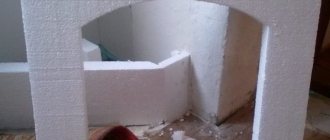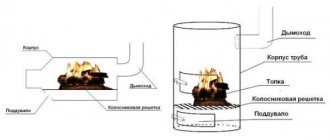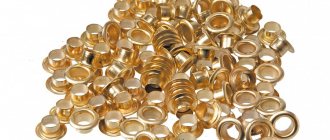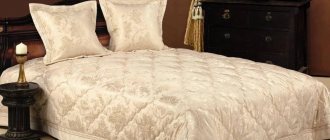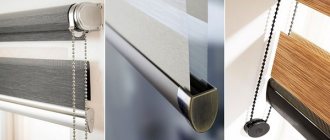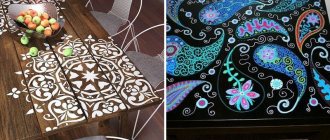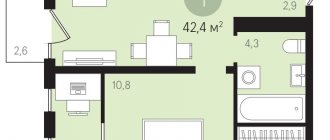If you use your imagination and ability to work with a sewing machine, you can cope with the task yourself, without resorting to the expensive help of specialists.
The length of the curtains - they were sewn wrong, we need a look from the outside
If the curtain is made with an arch or does not reach the window sill, then short tulle for the kitchen is decorated with braid, frills, and fringe. To prevent the sewn-in inserts from looking alien, we recommend sewing tiebacks for curtains or any other decorative elements (for example, pillowcases or tablecloths) from the same material.
A curtain in the form of a lambrequin - a very short tulle or a beautiful lambrequin is located under the cornice, and the light opening is covered with horizontal or roller blinds.
Next, all that remains is to turn the lambrequin out and iron it. You can try it on a curtain. A short tulle curtain looks harmonious with long curtains. Examples of curtain edging and decorative tie made from patchwork.
Also on this topic:
- Is it true that beautiful girls don't like jocks? But is it possible to eat ice cream? How often do you eat ice cream? This rule also applies to ice cream. Like any other product, you should eat ice cream at the right time and in small amounts.
- I'll give you a lick. She can't go to my lover, since I'm going to him myself. So she's going to my husband. My husband has two mistresses - Julia and Katya. Katya is currently on a business trip. Husband and wife lie in
- Traffic police fines photo recordingIf you saw a “flash on the highway”, this does not mean that you will necessarily be held accountable. The fact is that almost all car recorders are not properly tested.
If you bought tulle that turned out to be too long for your window or, conversely, too short, there is always a way out of this situation. You can easily hem the tulle, shortening it or lengthening it, depending on what you need, without even going to the workshop.
So where to start?
How to calculate fabric consumption for a curtain
Independent calculation of the amount of fabric required for sewing curtains includes three stages.
Determine length
First, the finished length of the future product is measured. To do this, you need to determine what the curtain should be:
- to the floor without touching. In this case, 1-2 cm are removed from the floor to prevent rapid wear;
- to the floor and lie on it like a train. Usually the train is made 5-10 cm;
- to the windowsill;
- 10 cm below the window sill, but not reaching the floor.
You might be interested in what a veil is: use to create curtains for windows
Curtain to window sill
You also need to determine how the curtain will be attached to the cornice. For example, to sew a curtain with eyelets, add 10-20 cm of interfacing tape to the length of the curtain itself.
Note! To the result obtained, add 5-8 cm for “shrinkage” and 2 cm on each side for processing the edges.
Define width
The width consumption is determined by adding three parameters:
- cornice width;
- assembly factor;
- allowances.
The gathering factor for tulle is 2-4, the allowance is 2 cm on each side.
Calculate the amount of fabric
If separate curtains are made, then for tulle with a pattern, two step lengths of the pattern are added to the length to make the curtains symmetrical.
Calculate the length of the tulle
If you need to shorten the tulle
This option is perhaps the simplest. Having figured out how to trim correctly, as well as choosing a needle and thread, you can safely get down to business! At the bottom you can decorate the seam with some kind of ribbon, fringe, etc. But, of course, such elements should be coordinated with the overall interior of the room, choosing color and design. If your tulle already has a beautiful trim at the bottom, then you can save it by peeling it off and reattaching it after you cut off the excess. Of course, you'll have to tinker, but it's worth it.
Preparation
In order to sew the ribbon onto the tulle, you must strictly follow the step-by-step recommendations.
It is attached to the upper free edge of the curtain material, which is why the final result of the finished product depends entirely on how well the braid is selected.
Important! For tulle, it is always best to choose sheer curtain tapes.
Once a special ribbon has been selected, an important point will be the process of determining its ideal length. Only by correctly calculating the size of the braid will it be possible to make beautiful, uniform folds.
When calculating, you also need to take into account the size of the cornice and the percentage of braid assembly.
Today, the most modern are ribbons with bow and pencil puffs, the assembly factor of which is 2.5. Thus, for 1 m of cornice it will be necessary to purchase 2.5 m of material. It is also easy to calculate the required footage, with a mounting length of 3 or 4 meters.
When making calculations, it is necessary to pay special attention to the additional costs of hemming along the edges.
Important! For tulle, you need to choose a braid with a high gathering coefficient.
When choosing a curtain tape, you need to carefully examine your purchase. If the fabric is highly wavy, the product is most likely of low quality and will quickly become unusable.
Selecting Tools
To perform all work, you need to prepare the equipment in advance:
- special tape;
- selected material for future curtains;
- threads;
- a needle;
- scissors;
- iron;
- sewing machine
If you need to lengthen the tulle
This task is much more difficult than the previous one. And if she is standing in front of you, then you have a direct route to the cutting and sewing store. They will offer a huge number of things that can come to the rescue: lace, guipure, fringe, ribbons and much more. You can even lengthen the tulle using simply beautiful material, sewing it to the bottom of the tulle with beautiful folds. By the way, in this case it will make the tulle heavier, which, of course, is beneficial. Just use your imagination, and you will definitely find a solution. The main thing here is not to make a mistake with the width of the purchased material, so that later it does not turn out that it will not be enough. It is worth measuring in advance the number of centimeters that are missing, adding another 6-8 to this number.
That, in principle, is all you need to know in order to cope with lengthening or shortening tulle. Good luck in your work, gentlemen!
Polyakova Yana, especially for the site All the Secrets of a Woman.
© 2012, All the secrets of a woman. All rights reserved. Any use of materials from the site “All the Secrets of a Woman” without an active link to the source open for indexing is prohibited!
Previous article: Why does cramping occur? Next article: How to get rid of fat on your sides?
On the same topic
Curtains “Cascade” - cut features
Ribbon roses
Pomander
The question of how to properly and beautifully lengthen curtains may arise for any housewife. There are different reasons for such a decision: after washing the fabric shrunk, there was a desire to make changes to the design of the curtains, the new apartment has higher ceilings and larger windows, etc. Let's find out ways to beautifully lengthen curtains from the bottom.
Extending the curtains
Methods
Today, many people have the opportunity to turn to professionals for help. To correct your curtains, a specialist will come to your home and discuss the style and color of the product with you, as well as take all measurements. However, not everyone has the opportunity to call a designer to their home or wants to create a masterpiece to decorate a window with their own hands. In this case, this article will help you do your own lengthening of curtains.
It's another matter if the curtains are very short. In this case, you will need to find a way to lengthen the curtains so that they look original and beautiful. The main thing is that the new curtains bring complete harmony to the overall interior design. There are several methods you can use to solve this DIY problem.
Other fabric
You can lengthen the curtains at the bottom with another fabric. At the same time, they try to use curtain fabric in the same style as the main material from which the curtains are made. If you need to lengthen the curtains by 10-15 cm, just undo the hem at the bottom and carefully iron the edge. However, this option is suitable if, when sewing the curtain, the hem was made of sufficient length. By opening the seams, releasing the remaining fabric and ironing the fabric well, the changes in the product will be invisible, as in the photo.
Update
If you don’t want to part with the length of these curtains, you can cut off the problematic lower part of the curtains and lengthen the curtains from below: the photo shows how to do this beautifully.
Step-by-step instructions on how to sew tulle with your own hands
For those who decide to sew tulle with their own hands, below are step-by-step instructions describing how this can be done.
Step 1. Selecting material for tulle
First of all, you need to decide on the design. Tulle is an important detail of the interior, so it should not only fit, but also emphasize it. Answers to the following questions can help with choosing a material:
- How sheer should the curtain be?
- What colour?
- What texture?
- Plain or patterned? Or maybe with embroidery?
Drawing on fabric
Important! You can mix different types of fabric to get something that suits your design.
Step 2. Correct cutting of the canvas
There are four ways to cut the canvas so that the edges remain smooth and the desired length:
- Along the fold. Using a ruler, mark equal distances along the length of the fabric, then bend the fabric and iron it. Cut with a knife from the inside.
- By thread. Measure the required length along the edge, make a small cut and pull out the thread. This leaves a noticeable mark along which the fabric is cut using scissors.
- Using a yardstick and scissors. Lay the fabric out on a flat surface and use a long piece of wood and a marker to mark the desired distance. Cut along the resulting line with scissors.
- Using a yardstick and a cutter. Place the fabric on a wooden surface, apply the required length of arshin and cut it using a cutter.
Important! Before ironing the fabric of the future curtain, you need to put a thin cotton material on it to avoid damage.
Step 3: Finishing the Edges
The material is not always cut evenly, and even high-quality fabric has frayed edges over time. There are three main ways to finish edges.
Important! You can take a fabric sample to check on it before starting work which edge treatment option you like best.
Processing edges on a machine
- Manually using a typewriter is the most commonly used method. The main thing is to choose the thread exactly to match the fabric so that it is less noticeable. It is enough to tuck thick fabric once, but it is better to tuck tulle twice. Before hemming on a typewriter, it is worth making a basting manually. It is not recommended to pin the fabric, as marks may remain on the thin material. The correct seam will only work if you sew confidently, then the stitching will be even.
- Using adhesive tape. The braid is easy to use; all you need is an iron. The edges are folded twice and a braid is pulled between the layers of fabric. Afterwards, all that remains is to walk over it with a hot iron. The fold line is neat, without punctures or threads.
- Edging. This will not only help protect the edges, but will also serve as an additional decorative element. You can use anything: ribbons, braid, lace or leftover fabric. In order for the edging to come out even, the tape or remaining fabric must be folded in half and ironed.
You might be interested in what fabrics are used for upholstering furniture
Edging
Important! Before you start finishing the edges, you should hang the curtains on the curtain rod for a couple of days. This is how they will take their final form.
Step 4: Creating folds in the curtains
Folds give curtains a special effect. And although folds in thick fabric will only make the curtains heavier, tulle is a light and thin material. How to make neat folds:
- Step back 1 cm from the top edge and draw a line parallel to it with a pencil or chalk.
- Mark strokes every 5 cm perpendicular to this line.
- Make folds, lightly basting them.
- Secure the folds on the machine.
Folds on a curtain
Making folds is a long and painstaking job, so you will have to be patient.
Step 5. Cutting and sewing the trim for the top of the curtain
Curtain tape is the “neck” of the curtain that holds everything else. This is usually a white strip of fabric that looks like a ribbon. In the middle along the entire length there is a dense layer of fabric with loops, by which the tulle is hung from the cornice. Improper fastening can cause the entire structure to collapse. Guide to sewing curtain tape:
- Hem the top edge.
- Step back 0.5 cm from the edge and baste the curtain tape. It should lie without folds or tightness.
- Sew by machine. The number of parallel lines should be equal to the number of cords in the tape.
- The edges of the curtain tape should be 1.5-2 cm shorter than the curtain.
- Fold in the side edges and stitch. They should be free.
- Pull the curtains to the desired width.
Sewing curtain tape
Please note! Do not cut off the loose ends of the cords; it is better to tie them and hide them behind the curtain. When washing, the fabric must be stretched to the full length of the cords.
How to transform any room with curtains
Women who know how to do this will make the new seam invisible. Of course, it is difficult to choose a pattern and color of fabric that would successfully match the main fabric. But you can choose a contrasting fabric that will match the curtains and look stylish. So, you can add a red hem to the bottom of light curtains, and fabric with a golden or silver tint, as shown in the video, will suit dark curtains.
Cornice
Sometimes the curtains are only missing a couple of centimeters. This problem can be solved in this way: lower the cornice a little lower.
Pendants
A very beautiful extension of curtains is performed using original pendants, which can be found in specialized stores. Such pendants can be made in the form of tassels made of bright silk threads, Swarovski glass, beads and pearls. Using this method, you can lengthen the curtains if they are short and achieve the length that you need. In addition, beautiful pendants can add special charm and elegance to the interior of your room. You can also make your own pendant that will fit perfectly into the style of your interior. To lengthen curtains made of fabric or tulle, you can find the right solution yourself. All that remains is to attach these products to the bottom edge of the canvas and your curtain will acquire the length you need. This method is not suitable if the curtains are very short. But even in this case, pendants can perfectly decorate a window opening.
Frill
Ruffles on curtains look very beautiful, especially on the kitchen window. This method must be approached carefully so as not to disturb the overall appearance of the product. If you have decorated your room in a minimalist style, then you should not lengthen the curtains with flounces and lush ruffles at the bottom. It’s better to create something airy and light:
Application
There are many other ways to beautifully lengthen short curtains with your own hands: using fabric loops, lambrequins, transverse inserts, etc. You can practice any methods yourself, and your curtains will take on the desired format, and the interior of the room will sparkle in a new way. It is worth noting that if your curtains belong to the category of luxurious and very expensive curtains, you should not try to lengthen them yourself. It is better to give such expensive things to professionals for restoration.
You can use any method to lengthen your curtains. The main thing is that you use your imagination and try to do the work carefully. All the methods described above can be used not only in extreme cases when you need to lengthen the curtains. They are also suitable for cases when you just want to change the design of curtains that you already have your eye on. Moreover, a do-it-yourself elongated curtain will always look more elegant and prettier.
Review of ways to beautifully lengthen curtains from the bottom.
8 ways to lengthen curtains if they are short
Are the curtains shorter than needed for some reason? Not a single housewife is immune from such a nuisance. I sewed curtains with my own hands and missed the calculations; I washed the new curtains, but the fabric shrank; After the housewarming party, it turned out that the ceilings in the previous apartment were much lower... But the result was the same: the curtains were short. And we need to rack our brains on how to lengthen them so that they don’t get even worse than they already are. We can do better! If you work on a sewing machine, it will not be difficult to correct such an error with your own hands, without resorting to the help of an atelier or repair shops. We will show you some interesting ways to get the missing length.
Types of fabric for tulle
To choose a fabric, you need to understand how different types differ from each other. They differ primarily by production method: smooth or patterned; by color and by the raw materials used.
Curtains for the room
Depending on the type of yarn and manufacturing variations, there are the following types of fabric:
- Organza. Transparent, lightweight, but dense and rigid material that holds its shape well. It is made from polyester, but there are expensive models made from silk or viscose. Poor air permeability.
- Net. Thick fabric with holes that allow light to pass through easily. Typically made from synthetic fibers. Great for the kitchen.
- Muslin. Lightweight, soft fabric made from fine threads. It allows air to pass through well, is easy to wash and dries quickly. Silk, cotton or wool are used for production.
- Veil. A thin translucent matte fabric that is most often used to sew curtains. It is made from cotton, silk, wool or linen. Lightweight, holds its shape well, although it collects dust a lot, gets dirty and fades. Perfect for the hall.
- Gas. This type of fabric has transparent, thin and light material. Usually made of silk, but sometimes they are made of synthetics.
Types of Fabric
All of these materials can make excellent curtains. You just have to figure out how to sew beautiful tulle on the windows.
Eyelets
This method looks especially beautiful on tulle curtains. After all, to insert metal fittings on top, you need to “extend” the canvas with a denser fabric (matching or contrasting - the general style of the interior will tell you). And the combination of two such textures looks very impressive - it is a contrast in itself.
When inserting eyelets with your own hands, you should consider the following:
- this method of fastening involves raising the upper part of the curtain above the level of the cornice, so you need to correctly calculate its location above the window so that the fabric above it can be placed freely;
— the cornice in this case should be round in cross-section, without additional hooks or clips;
- the fabric under the eyelets should not seem foreign. If the curtains have a pattern, it is desirable that one of its shades be repeated in the added fabric. Or a contrasting color was chosen to match the main curtain.
Tulle over curtains
In modern interior styles you can often find extraordinary window designs. For example, openings where thick curtains are considered basic and tulle is considered additional. For this design, you first need to hang curtains on the cornices, and then two pieces of tulle. Thick curtains are hung to form voluminous folds, and thin curtains on top of them are gathered into a bun in the middle. But you can save money on this type of window decoration if you order tulle with curtains two in one. Such curtains are usually sewn together. They are purchased for such design trends as modern, modern, high-tech.
Burgundy chiffon for a large window in the hall Source qdh.net
Tulle and curtain in one texture without a pattern for spacious rooms Source mydizajn.ru
Lambrequin
Another option is how you can lengthen the curtains at the top of the canvas. It is believed that a lambrequin can only visually stretch the curtains. However, you can cheat here too. Fix the curtain rod directly above the window opening (if the curtains are long enough in this position), and hang the second curtain rod, for the lambrequin, 10 centimeters higher - it will cover the upper border of the curtains themselves, and the ensemble will form an overall elongated composition.
Well, now - several ways on how you can lengthen short curtains or tulle at the bottom with your own hands.
Tulle mesh: how to sew curtain tape?
The curtain tape is sewn to the tulle mesh.
For the tulle mesh, it is recommended to use a translucent nylon ribbon. In this case, the ribbon will be less noticeable. Choose the color of the fabric. The width of the strip is no more than 6 centimeters . How to sew curtain tape to mesh tulle? First prepare the tulle and ribbon:
- Leave an extra 3-4 cm on each side of the braid.
- Also leave extra centimeters ( 3-4 cm ) near the fabric.
- During work, do not allow strong tension on the fabric and threads.
Step-by-step instruction:
- Iron all the tulle. Fold 1 centimeter of fabric over the top and iron.
- A curtain ribbon is applied to the folded fabric. 5 millimeters from the edge .
- Use a thread to secure the ribbon to the fabric.
- Sew evenly on the machine. There are as many lines as there are cords in the tape.
- Trim the ribbon so that each edge is one and a half centimeters shorter than the fabric.
- Make two folds on the fabric. First, fold it completely, then part of the tape.
- Sew the edges of the fabric. The main thing is that the cords are not sewn into the collar.
- Pull the tulle to the required width.
To secure the tulle, it is most convenient to use special clothespins.
Ruffles
This method is suitable if your room is decorated in a romantic style: Provence or shabby chic. Ruffles are also appropriate in country style.
A spectacular gathering along the bottom edge of the curtains, lovingly done with your own hands, will not only add length, but also make the interior more elegant.
Just remember the same rule: the fabric for ruffles must be consistent with the main material in texture and color combination. If a contrasting option is chosen, it is better to complement the frill with the same element at the top of the curtains. Then the elegant extension will look harmonious and not deliberate.
Thin curtains in a classic style
The classic style of curtains is considered the most popular among different types of decoration. To create a neat atmosphere in the room, you can use specially tailored curtains in a classic style. You can create the effect of wealth and perfection with your own hands by properly decorating the curtains with drapery, wide rope laces, ruffles and fringe.
Curtains with an interesting design of the bottom edge in a classic style Source cozyblog.ru
Transparent white curtain and thick drapery with a bunch of gathers Source art-interior.moscow
Combination of blinds and tulle on windows in a classic style Source yellowhome.ru
When choosing curtains in a classic style, you need to give preference to textures such as silk, taffeta, brocade, and satin. In this interior direction, curtains look stylish, rich and unique. You can dilute the tulle with nightcloths with a golden tint.
Learning to combine options
Let's start simple
The simplest combination is to make inserts from a different material, cutting off part of the curtains closer to their upper and lower edges. A single insert does not always look organic. Often such a stripe gives the curtains the appearance of clothes that were too small, so they added them. This will expose your problem to your guests. The combination of two stripes is more natural.
It is clear that here it is also necessary to proceed from the general style of the room, color schemes, and the quality of the fabric itself. Ideally, the insert should have the same texture. A romantic example is inserts of lace stripes.
Let's try something more complicated
More complex methods will require subtle taste from you: the more details, textures and techniques you need to combine, the more difficult it is to do it correctly. For example, the following combinations are good:
- eyelets plus an additional strip of the same fabric as under them, somewhere below the window sill;
— fastening with hinges plus an insert from a strip of the same fabric, similar to the previous option;
— lambrequins plus ruffles;
- ruffles plus tiebacks;
- lambrequins, ruffles plus tiebacks.
Your imagination will suggest other original combinations. Imagination, taste and resourcefulness can generally save you from many unpleasant accidents. We hope that after reading this article you will overcome at least one of them without difficulty.
More information on the topic: https://shtorydom.ru
Types of curtain tapes: overview
Types of curtain tapes
Curtain tape is a fabric strip that is sewn to the back of the product. The ribbon contains cords that allow you to adjust the width of the material.
Braid can create a chic drapery on any fabric. It is also convenient that you do not need to sew additional loops for hooks. This reduces the time of sewing tulle and helps to quickly pull it together with thread on the sides. The braid allows you to adjust and fix the width of the curtain.
Designers use several types of curtain tapes. Here's their review:
- Narrow ribbon - up to 4 cm .
- Wide - up to 15 cm.
- With tucks.
- Forming bows.
- With a small number of draw-out pockets for hooks and an increased number of them.
- Different in assembly coefficient - from 1.5 to 3 . This determines how often the folds will be placed on the product.
- Sew-on - attached to the product using a seam. cars.
- Adhesive to the product with a hot iron.
- Fixed to the cornice using adhesive tape with loops.
Also, the curtain tape can come complete with the following items:
- Eyelet rings
- Special seals
- Pockets for fastening with hooks
- Cords for tie.
When selecting braid, you need to take into account its length, which depends on the size of the folds that you want to create on the product.

